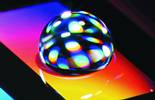
Bell Labs’ scientists have discovered an entirely new method to control the behaviour of tiny liquid droplets by applying electrical charges to specially engineered silicon surfaces that resemble blades of grass.
They believe the new technique of manipulating fluids has many potential applications, including thermal cooling of integrated circuits, novel photonic components for optical communications, and small, low-cost 'lab-on-a-chip' sensor modules.
The scientists used a new technique to process silicon surfaces to produce 'nanograss' with individual blades only nanometers in size. It lets liquids interact with surfaces in a novel way, providing a way to precisely control their effects. The individual blades of the nanograss are so small, however, that liquid droplets sit on top and can be easily manoeuvred.

The Bell Labs team coated the nanograss with a non-stick, water-repellent material, and when the droplets are put on the surface, they can move about without wetting it. By applying a small voltage, however, the behaviour of droplets can be tailored, making them sink in and wet the surface as directed. The droplets also respond to a change in temperature, allowing for thermal cooling applications.
Such behaviour may be harnessed to cool computer chips, they say. A droplet could be sent to a hot spot on the chip, where it would sink in and absorb the heat, and then go on its way, avoiding the expense and inefficiency of applying a coolant or a heatsink to an entire chip. Another application for this technique may be in optical networking. For example, moving a droplet of fluid into a nanograss surface can alter the physical properties of the transmitting medium through which light signals are sent, and this may lead to better methods for optical switching, according to the team. Novel optical components, such as filters, could be created by moving the fluid into and out of nanograss areas.
Also being explored is using the technique to create powerful, next-generation reserve micro batteries. Conventional batteries have electrochemical reactions proceeding at some level all the time, even when batteries are not being used. Over time, the batteries degrade. By using the Bell Labs technique to isolate the liquid electrolyte so that electrochemical reactions do not take place until power is actually needed, nanograss-based micro batteries may be ideal for long-term, higher capacity battery applications, especially where bursts of power are needed.
Yet another application for the nanograss may be so-called 'lab-on-a-chip' devices. Here, devices would use thousands of different reagents, each deposited in a small spot at the bottom of the nanograss, thus providing novel devices for combinatorial chemistry, genetic analysis, and so on, according to the researchers.
© Technews Publishing (Pty) Ltd | All Rights Reserved